Summers in Texas are brutal, especially if you’re a chicken locked up in your coop every evening. Sure, it’s for their own protection but on those evenings with little or no breeze, it can get very stuffy. Adding an electric fan would help but running a 200 foot extension cord was out of the question. Fortunately, during the summer there’s also an abundance of sunlight. Adding a solar powered fan seemed like the perfect plan.
Why do I lock my chickens in a coop every evening? That’s a story onto itself. When I moved to the country, my first construction project was a chicken coop. Fresh eggs and chicken, what could be better? My wife had agreed in principle but when I come home one day to find she had named all twenty chickens, I realized that I would have to settle for fresh eggs. It wasn’t long before I discovered I wasn’t the only one who liked fresh chicken.
It seems that raccoons, coyotes and the occasional owl also enjoy fresh chicken. Worse, they all agreed my chicken coop was a great dining establishment. To the dismay of the local wildlife, my second coop was more of a gulag than a coop. Still, time and determination finally won out and I found myself building a third coop. This time I thought of everything except active ventilation and so I started on the solar powered chicken coop fan project.
As always, planning was the initial phase. Although the chickens are confined to their run during the day, unless they’re laying eggs, they stay outside. My fan would be needed during the night, not the day. That meant adding a battery to the system. Charge the battery during the day and let the fan run at night.
Let’s go through the parts list:
Although all items were purchased on Amazon, I haven’t provided links. Prices tend to fluctuate and Amazon’s stock changes frequently. For example, the solar power controller I bought is sold under different names and prices by at least three vendors and I already had some nice 12 volt batteries scavenged from a UPS that died an early death.
On a project like this, everything should be driven by the power requirements of the fan. My original selection was a 12 volt ceiling fan. A reasonable blade size gave me power usage of approximately one amp, which meant my battery had to provide one amp for at least six hours.
Halfway into the project, my wife questioned me on the fan and pointed out that an open fan in a crowed chicken coop was probably a bad idea. Something about the blender effect. She used a few more words than that but she was right. I started looking at shrouded fans and almost abandoned the project. The typical shrouded 12 volt fan on Amazon is intended for use as a radiator fan replacement, lots of air, but current draw was on the order of 6 amps.
Wattage is a simple calculation, current X voltage, 72 watts in this case, but when you’re talking about solar panels, you also have to factor in full sunlight, aging of the panel and optimal load. This would raise my solar panel size significantly above 100 watts. Right about the time it gets very expensive. Back to the hunt.
The RoadPro RP8000 fan is only 10 inches but it’s shrouded, operates off of batteries and is designed for use in small RVs. Better yet, it draws only 0.8 amps at max setting. I decided to give it a try and can’t say I’ve been disappointed.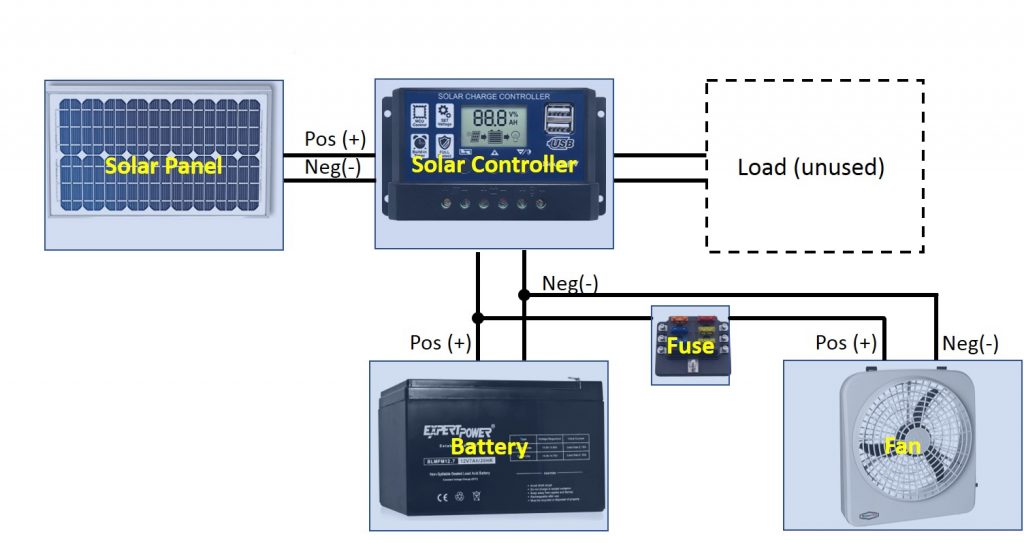
Wiring Diagram
[This has been updated to reflect what I learned in my solar fountain project. Please see The Solar Chicken Coop Fan Project Revisited for the newer diagram and why it changed.]
Follow the above diagram and you should end up with a working system. The picture below shows the inside of the enclosure and the inside of the coop with the fan.
Putting the system together was remarkably easy. I only had a few issues.
- Putting the solar panel on the coop roof was a good idea, but the roof was shaded by a large tree. I ended up placing the panel about twenty feet from the coop.
- It took a few days to convince the chickens that the fan was safe. We had to herd the chickens into the coop the first few nights. Now they accept the noise as normal and no longer have to be herded inside.
- Looking at my diagram, you can see I ignored the output of the controller and connected the fan directly to the battery. While this was deliberate, I’m rethinking this. It allows the fan to continue running when the battery is low but a few cloudy days could drain the battery completely, always a bad idea for a lead-acid battery. The controller has an option to set the battery shut off threshold that I need to take advantage of this.
The system has been running for almost four weeks now with no issues. Although the battery drops to almost eight volts, the fan is still running when we release them in the morning.
I should caution you about one other issue that cropped up. Now that my wife knows what I can do, she’s thinking about other solar powered projects.
Update 6/2/2019: Not wanting to freeze out my chickens, I turned off the fan for the winter. Sometime in June, the nighttime temperature was high enough to turn the system back on. No surprises, the system worked fine. Two days later when I beat the sun to feed the chickens, the fan wasn’t running. Remembering that my battery was salvaged from a defunct UPS, I decided to skip troubleshooting and go straight to battery replacement. It was a good guess, I was out about $25 dollars and the chichens were able to enjoy their fan all night. I placed my control box in the open for easy access. In hind sight, I should have placed the battery in the shade to protect if from the Texas sun.
You might also want to see how I finished my solar fountain. I took a number of wrong turns before I came up with a system capable of running my fountain all night.
© 2018 – 2020, Byron Seastrunk. All rights reserved.

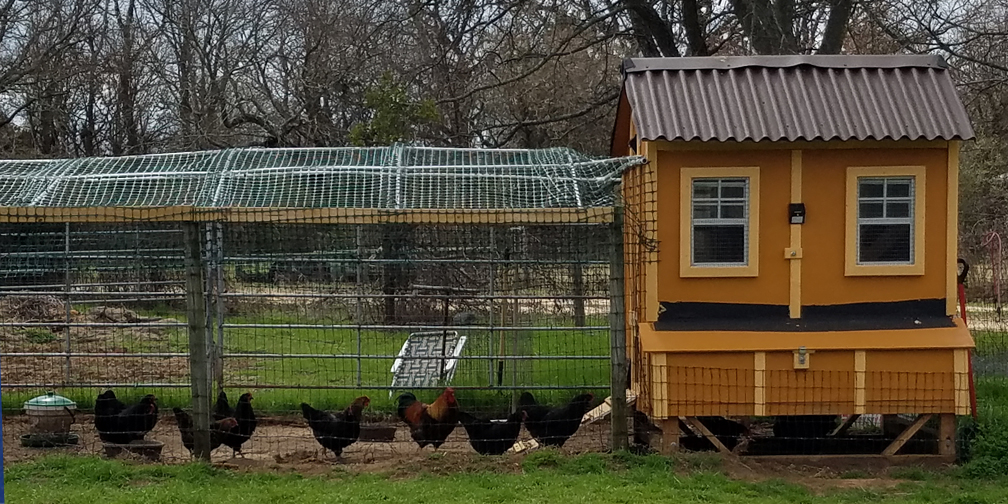
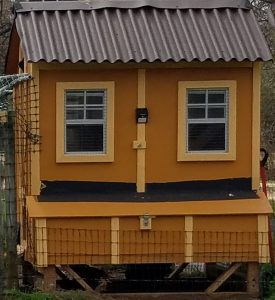
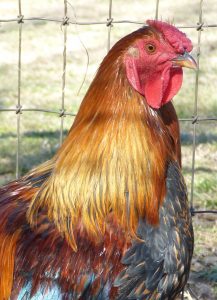
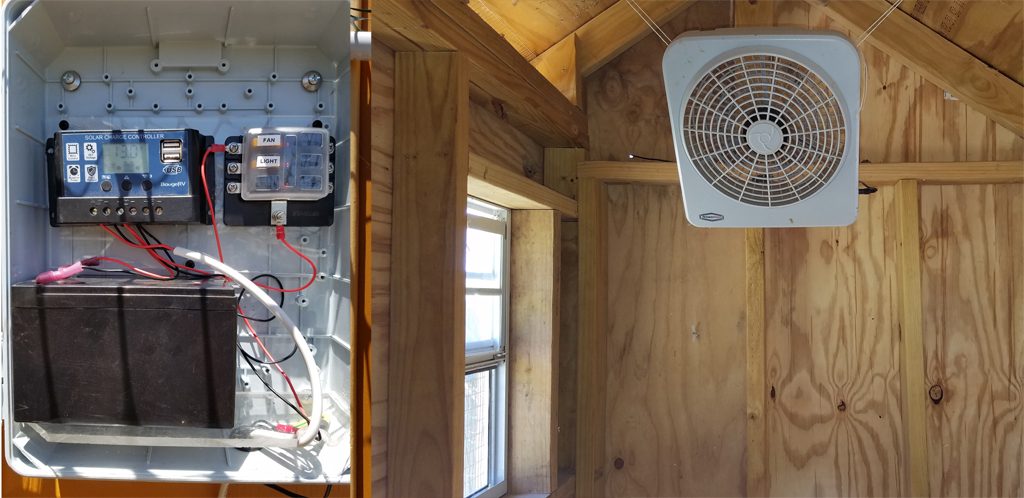










Hi Byron, is there a product you know of that comes together that I could just mount? Not sure if you saw any in your researching. I’m not technically inclined but can mount and plug something in lol. I’m having a hard time finding a good review on Amazon about a solar fan with battery back up.
Thanks….From hot humid Florida!
Not that I’ve seen. You might find one that could operate while you had sun but getting the fan to operate at night is a problem. Most solar fans don’t have the storage capacity you need. On the other hand, it’s really not much harder than following directions and not getting your red and black mixed up. I’ve changed my setup a few times since that post. Maybe it would be worthwhile to see how simple I can make the installation. Keeping my chickens separated from the predators seems to be the harder task.
You are so good with the solar, look into solar electric fence for the 4 legged predators!
It’s a good idea but solar powered electric fences have been around for years. Unfortunately electric fences are better suited to coyotes, dogs and other predators. The hot wire has to be very close to the ground to keep out the smaller predators and that causes a number of other problems. A solar powered laser deterrent with AI discrimination is very possible using today’s technology but seems like an open invitation to disaster I’m going to stick with a fenced chicken run during the day and locking them in the coop at night. Still, it’s a great idea. Thanks for the comment.
Install a second battery in parallel, post to post, neg to neg, increases your amp hours. Put a timer on it, shuts it off at 3 or 4 am when it is cooler outside.
Thanks for the suggestions. I’ve always avoided tying two batteries in parallel unless I added diode isolation. As it is, the battery keeps the fan running throughout the night. Probably a good idea for our Texas summer. The solar controller I used has a timer but I haven’t had a need for it.
Think bigger for next project, solar powered air conditioner for the chickens:-)
As Tim Taylor would say, more power …